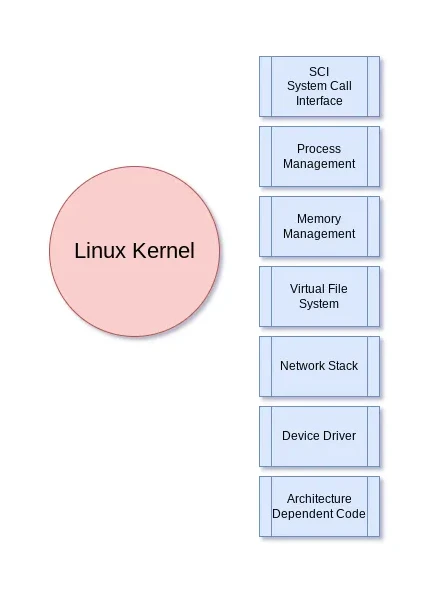A Kernel is the core component of an operating system that manages system resources and hardware communication. In Linux, the kernel acts as an intermediary between software applications and the computer’s hardware, handling tasks like process management, memory management, and device control. It ensures that different programs can run simultaneously without interfering with each other, manages system memory, and handles input/output operations for devices like hard drives and network interfaces. The Linux kernel is open-source, highly customizable, and is used as the foundation for various Linux distributions.

- System Call Interface (SCI): The mechanism by which user-space applications request services from the Linux kernel. The System Call Interface (SCI) allows programs to execute privileged operations like file manipulation, process control, and networking by transitioning from user mode to kernel mode. The kernel uses a system call table to map each system call (e.g., `read()`, `write()`, `fork()`) to the appropriate kernel function. This interface is crucial for maintaining system security, as it controls how applications interact with hardware and manage resources.
- Process Management: The Linux kernel’s process management involves the creation, scheduling, and termination of processes. The kernel uses data structures like the process control block (PCB) to track process states (running, waiting, etc.), manage resources (CPU time, memory), and handle process communication and synchronization. Key kernel functions include
fork()to create processes,exec()to load new programs into memory, and the Completely Fair Scheduler (CFS) to allocate CPU time efficiently. Understanding process management in the Linux kernel is essential for optimizing system performance and ensuring smooth multitasking. - Memory Management: The Linux kernel’s memory management subsystem handles the allocation, deallocation, and mapping of memory for processes. It manages physical and virtual memory, using techniques like paging and swapping to efficiently use RAM and support multitasking. Key components include the Virtual Memory Manager (VMM), which maps virtual addresses to physical memory, and the Page Cache, which speeds up access to frequently used data. The kernel also handles memory protection, ensuring that processes cannot access each other’s memory space, which is crucial for system stability and security.
- Virtual File System (VFS): The VFS is an abstraction layer in the Linux kernel that provides a uniform interface for different types of file systems. It allows the kernel to interact with various file systems (e.g., ext4, NFS, FAT) in a consistent manner, regardless of their underlying implementation. The VFS handles system calls related to file operations, such as
open(),read(), andwrite(), and maps them to the appropriate file system driver. This abstraction enables Linux to support multiple file systems simultaneously, making it highly versatile and extensible. - Network Stack: The Linux kernel’s network stack is responsible for handling all network communication, from low-level hardware interactions to high-level protocols like TCP/IP. It consists of multiple layers, each managing different aspects of networking, such as packet routing, filtering, and socket communication. Key components include the Network Interface Layer, which interacts with network hardware, the IP Layer, which handles routing and addressing, and the Transport Layer, where protocols like TCP and UDP operate. The stack is modular, allowing for easy extension and support for various network protocols and devices, making Linux a powerful platform for networking.
- Device Driver: A device driver is a kernel module that allows the Linux kernel to communicate with hardware devices, such as disk drives, network cards, and peripherals. Device drivers act as an interface between the kernel and hardware, translating kernel requests into actions the hardware can perform. In Linux, drivers can be either compiled directly into the kernel or loaded as loadable kernel modules (LKMs). Drivers handle tasks such as sending and receiving data, interrupt handling, and device configuration. The Linux device driver model abstracts hardware details, providing a standardized interface to the kernel while supporting a wide range of devices.
- Architecture Dependent Code: This refers to the portions of the Linux kernel that are specific to a particular CPU architecture, such as x86, ARM, or RISC-V. Architecture-dependent code includes low-level details like how the kernel manages memory, handles interrupts, performs context switching, and interfaces with hardware. These code segments are often found in directories named after the architecture (e.g.,
arch/x86/orarch/arm/in the kernel source tree). This separation allows the Linux kernel to support multiple hardware architectures while keeping the core kernel code architecture-independent and portable across different systems.





